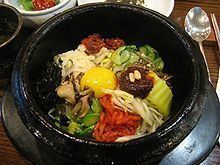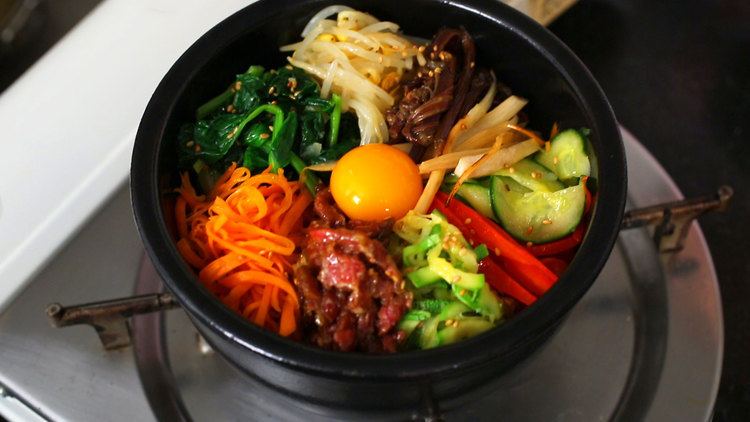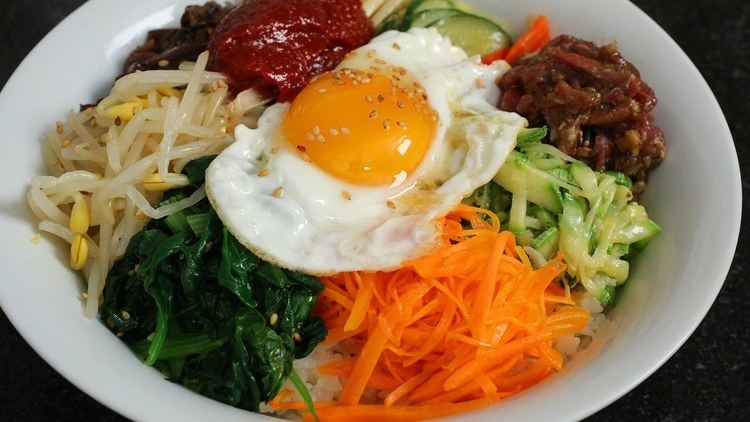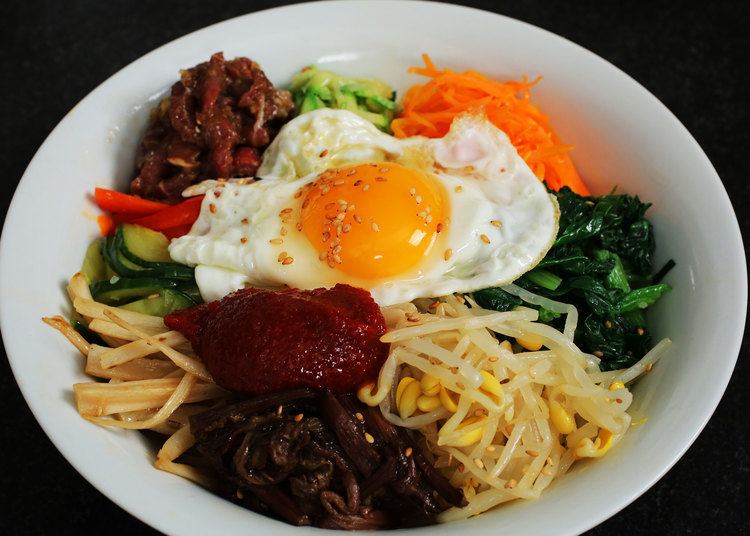Type bap Associated national cuisine South Korea | Place of origin Korea | |
 | ||
Similar | ||
Korean bibimbap recipe
Bibimbap (/ˈbiːbɪmbæp/; from Korean 비빔밥; sometimes anglicized as bi bim bap or bi bim bop) is a Korean dish. The word literally means "mixed rice". Bibimbap is served as a bowl of warm white rice topped with namul (sautéed and seasoned vegetables) and gochujang (chili pepper paste), soy sauce, or doenjang (a fermented soybean paste). A raw or fried egg and sliced meat (usually beef) are common additions. The hot dish is stirred together thoroughly just before eating.
Contents

In South Korea, Jeonju, Jinju, and Tongyeong are especially famous for their versions of bibimbap. In 2011, it was listed at number 40 on the World's 50 most delicious foods readers' poll compiled by CNN Travel.

Bibimbap dolsot bibimbap
History

The name bibimbap was adopted in the early 20th century. From the Joseon Period (1392–16th century) until the 20th century, Bibimbap was called goldongban, which means rice made by mixing various types of food. This dish was traditionally eaten on the eve of the lunar new year as the people at that time felt that they had to get rid of all of the leftover side dishes before the new year. The solution to this problem was to put all of the leftovers in a bowl of rice and to mix them together. Bibimbap is also thought to have been eaten by farmers during farming season as it was the easiest way to make food for a large amount of people. Bibimbap was served to the king usually as a lunch or a between-meal snack.

Bibimbap is first mentioned in the Siuijeonseo, an anonymous cookbook from the late 19th century. There its name is given as 부븸밥 (bubuimbap). Some scholars assert that bibimbap originates from the traditional practice of mixing all the food offerings made at an ancestral rite (jesa) in a bowl before partaking in it.

Since the late 20th century, bibimbap has become widespread in different countries, due to its convenience of preparation. It is also served on many airlines connecting to South Korea.
Preparation
Vegetables commonly used in bibimbap include julienned cucumber, zucchini (courgette), mu (radish), mushrooms, doraji (bellflower root), and gim, as well as spinach, soybean sprouts, and gosari (bracken fern stems). Dubu (tofu), either plain or sautéed, or a leaf of lettuce may be added, or chicken or seafood may be substituted for beef. For visual appeal, the vegetables are often placed so adjacent colors complement each other. In the South Korean version, sesame oil, red pepper paste (gochujang), and sesame seeds are added.
Variations
A variation of this dish, dolsot-bibimbap (돌솥 비빔밥) or hot stone pot bibimbap (dolsot meaning "stone pot"), is served in a very hot stone bowl in which a raw egg is cooked against the sides of the bowl. The bowl is so hot that anything that touches it sizzles for minutes. Before the rice is placed in the bowl, the bottom of the bowl is coated with sesame oil, making the layer of the rice touching the bowl cook to a crisp, golden brown (누릉지). This variation of bibimbap is typically served to order, with the egg and other ingredients mixed in the pot just prior to consumption.
The city of Jeonju (전주), the capital of the North Jeolla Province of South Korea, is famous throughout the nation for its version of bibimbap, said to be based on a royal court dish of the Joseon Dynasty.
A further variation of bibimbap, called hoedeopbap (회덮밥), uses a variety of raw seafood, such as tilapia, salmon, tuna or sometimes octopus, but each bowl of rice usually contains only one variety of seafood. The term hoe in the word means raw fish. The dish is popular along the coasts of Korea where fish are abundant.
There are numerous other kinds of bibimbap as well, such as sprout bibimbap, wild herb bibimbap, and brass bowl bibimbap.
Symbolism
Bibimbap ingredients are rich in symbolism. Black or dark colours represent North and the kidneys – for instance, shiitake mushrooms, bracken ferns or laver. Red or orange represents South and the heart, with chilli, carrots, and jujube dates. Green represents East and the liver, with cucumber and spinach. White is West or the lungs, with foods such as bean sprouts, radish, and rice. And finally yellow represents the centre, or stomach. Foods include pumpkin, potato or egg.
